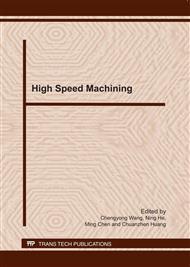[1]
Y. Lin, Y. Shen. Enhanced virtual machining for sculptured surfaces by integrating machine tool error models into NC machining simulation. International Journal of Machine Tools & Manufacture, Vol. 44 (2004), p.79–86.
DOI: 10.1016/j.ijmachtools.2003.08.003
Google Scholar
[2]
S.P. Radzevich. A closed-form solution to the problem of optimal tool-path generation for sculptured surface machining on multi-axis NC machine. Mathematical and Computer Modelling, Vol. 43 (2006), p.222–243.
DOI: 10.1016/j.mcm.2004.08.014
Google Scholar
[3]
E. Shamoto, N. Suzuki, E. Tsuchiya, Y. Hori, H. Inagaki, K. Yoshino. Development of 3 DOF Ultrasonic Vibration Tool for Elliptical Vibration Cutting of Sculptured Surfaces. CIRP Annals - Manufacturing Technology, Vol. 54 (2005), pp.321-324.
DOI: 10.1016/s0007-8506(07)60113-9
Google Scholar
[4]
C-J. Chiou, Y-S Lee. A machining potencial field approach to tool path generation for multi-axis sculptured surface machining. Computer-Aided Design, Vol. 34 (2002), pp.357-371.
DOI: 10.1016/s0010-4485(01)00102-6
Google Scholar
[5]
L.N. López de Lacalle, A. Lamikiz, J. Muñoa, J.A. Sánchez. Quality improvement of ball-end sculptured surfaces by ball burnishing. International Journal of Machine Tools & Manufacture, Vol. 45 (2005), pp.1659-1668.
DOI: 10.1016/j.ijmachtools.2005.03.007
Google Scholar
[6]
L.N. López de Lacalle, A. Lamikiz, J.A. Sánchez, J.L. Arana. The effect of ball burnishing on heat-treated steel and Inconel 718 milled surfaces. International Journal of Advanced Manufacturing Technology, Vol. 123 (2) (2002), pp.292-302.
DOI: 10.1007/s00170-005-0402-5
Google Scholar
[7]
F-J Shiou, C-H Chen. Freeform surface finish of plastic injection mold by using ball-burnishing process. Journal of Materials Processing Technology, Vol. 140 (2003), pp.248-254.
DOI: 10.1016/s0924-0136(03)00750-7
Google Scholar
[8]
A. Celaya, A. Rodríguez, J. Albizuri, L.N. López de Lacalle, R. Alberdi. Modelo de elementos finitos del bruñido. IX Congreso Iberoamericano de ingeniería mecánica, Las Palmas de Gran Canaria, España, (2009).
DOI: 10.5944/bicim2022.221
Google Scholar
[9]
Ecoroll, Applications of deep rolling 4088_3e, www. ecoroll. com/4088_3e. pdf, [accessed 10/3/2010].
Google Scholar
[10]
L.N. López de Lacalle, A. Lamikiz, J. Muñoa, M.A. Salgado, J.A. Sánchez. Improving the high-speed finishing of forming tools for advanced high-strengh steels (AHSS). International Journal of Advanced Manufacturing Technology, Vol. 29 (2006).
DOI: 10.1007/s00170-004-2482-z
Google Scholar


